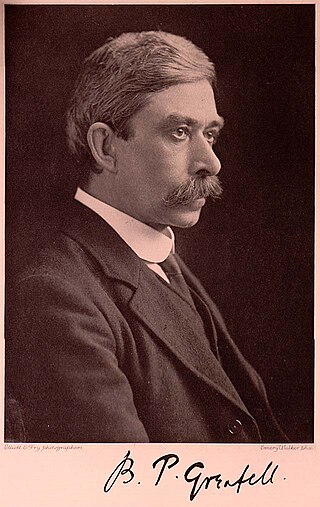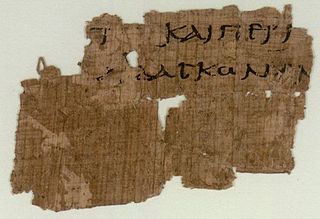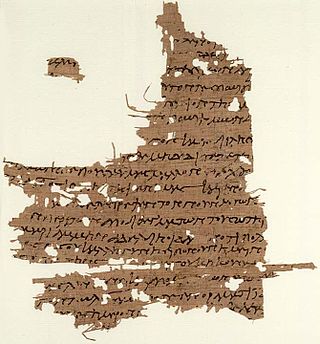
Papyrus is a material similar to thick paper that was used in ancient times as a writing surface. It was made from the pith of the papyrus plant, Cyperus papyrus, a wetland sedge. Papyrus can also refer to a document written on sheets of such material, joined side by side and rolled up into a scroll, an early form of a book.

Oxyrhynchus is a city in Middle Egypt located about 160 km south-southwest of Cairo in Minya Governorate. It is also an archaeological site, considered one of the most important ever discovered. Since the late 19th century, the area around Oxyrhynchus has been excavated almost continually, yielding an enormous collection of papyrus texts dating from the Ptolemaic Kingdom and Roman Egypt. They also include a few vellum manuscripts, and more recent Arabic manuscripts on paper

Bernard Pyne GrenfellFBA was an English scientist and egyptologist.

The Papyrology Collection of the University of Michigan Library is an internationally respected collection of ancient papyrus and a center for research on ancient culture, language, and history. With over 7,000 items and more than 10,000 individual fragments, the Collection is by far the largest collection of papyrus in the country, and offers a glimpse into the everyday life and language of the ancient world. Of keen interest to historians, linguists, classicists, philosophers, archaeologists, as well as others, the collection includes biblical fragments, religious writings, public and private documents, private letters, and writings on astronomy, astrology, mathematics, and magic. The papyri span nearly two millennia of history, dating from about 1000 BC to AD 1000, with the majority dating from the third century BC to the seventh century AD.

The Oxyrhynchus Papyri are a group of manuscripts discovered during the late nineteenth and early twentieth centuries by papyrologists Bernard Pyne Grenfell and Arthur Surridge Hunt at an ancient rubbish dump near Oxyrhynchus in Egypt.

Papyrus 102, designated by 𝔓102, is an early copy of the New Testament in Greek. It is a papyrus manuscript of the Gospel of Matthew. The surviving texts of Matthew are verses 4:11-12; 4:22-23, they are in a fragmentary condition. The manuscript palaeographically has been assigned to the 3rd century.

Papyrus Oxyrhynchus L 3525 is a copy of the apocryphal Gospel of Mary in Greek. It is a papyrus manuscript formed in a roll. The manuscript had been assigned palaeographically to the 3rd century. It is one of the three manuscripts and one of the two Greek manuscripts of the Gospel of Mary. It is shorter than Papyrus Rylands 463.

Papyrus 125, designated by 𝔓125, is an early copy of the New Testament in Greek. It is a papyrus manuscript of the First Epistle of Peter. Using the study of comparative writing styles (palaeography), the manuscripts has been dated by the INTF to the 3rd or 4th century.
Guido Bastianini, Italian papyrologist and palaeographer.
Dirk D. Obbink is an American papyrologist and classicist. He was Lecturer in Papyrology and Greek Literature in the Faculty of Classics at Oxford University until 6 February 2021, and was the head of the Oxyrhynchus Papyri Project until August 2016. Obbink was also a fellow and tutor in Greek at Christ Church Oxford, from which role he was suspended in October 2019, as a result of allegations that he had stolen some of the Oxyrhynchus papyri and sold them to the Museum of the Bible.

Papyrus Oxyrhynchus 8 is a fragment of Greek hexameter poetry. The dialect is a mixture of Aeolic and Doric. It was discovered by Grenfell and Hunt in 1897 in Oxyrhynchus. The fragment is dated to the first or second century. It is housed in the Houghton Library, Harvard University, with the catalogue number SM2211. The text was published by Grenfell and Hunt in 1898.
Papyrus Oxyrhynchus 210 is an early Christian fragment, written in Greek. It was discovered in Oxyrhynchus. The manuscript was written on papyrus in the form of a codex. It is dated to the third century. Currently it is housed in the Cambridge University Library (4048) in Cambridge.

Papyrus Oxyrhynchus 5101, designated by 2227 or P.Oxy.LXXVII 5101 is a manuscript of the Psalms in the Greek Septuagint version, written on papyrus in roll form. It has survived in only a few fragments. Using the study of comparative writings styles (palaeography), it has been dated to between 50 and 150 CE.
Peter John Parsons, was a British classicist and academic specialising in papyrology. He was Regius Professor of Greek at the University of Oxford from 1989 to 2003.
Petra Marieke Sijpesteijn is professor of Arabic at Leiden University. She was the founding president of the International Society for Arabic Papyrology.

Medea Vittoria Irma Norsa (1877–1952) was an Italian papyrologist and philologist. She headed the Istituto Papirologico Girolamo Vitelli in Florence from 1935 to 1949.
American Studies in Papyrology is a book series established in 1966 by the American Society of Papyrologists. The series editors are James Keenan (editor-in-chief), Kathleen McNamee, and Arthur Verhoogt.
Papyrus Oxyrhynchus 581 is a papyrus fragment written in Ancient Greek, apparently recording the sale of a slave girl. Dating from 29 August 99 AD, P. Oxy. 581 was discovered, alongside hundreds of other papyri, by Bernard Pyne Grenfell and Arthur Surridge Hunt while excavating an ancient landfill at Oxyrhynchus in modern Egypt. The document's contents were published by the Egypt Exploration Fund in 1898, which also secured its donation to University College, Dundee, later the University of Dundee, in 1903 – where it still resides. Measuring 6.3 x 14.7 cm and consisting of 17 lines of text, the artifact represents the conclusion of a longer record, although the beginning of the papyrus was lost before it was found. P. Oxy. 581 has received a modest amount of scholarly attention, most recently and completely in a 2009 translation by classicist Amin Benaissa of Lady Margaret Hall, Oxford.

A New Testament amulet is an ancient hand-written portion of the New Testament, commonly worn as a charm. The Lord's Prayer is the most common text found on amulets. Also commonly found are the opening verses of each of the four New Testament gospels.












